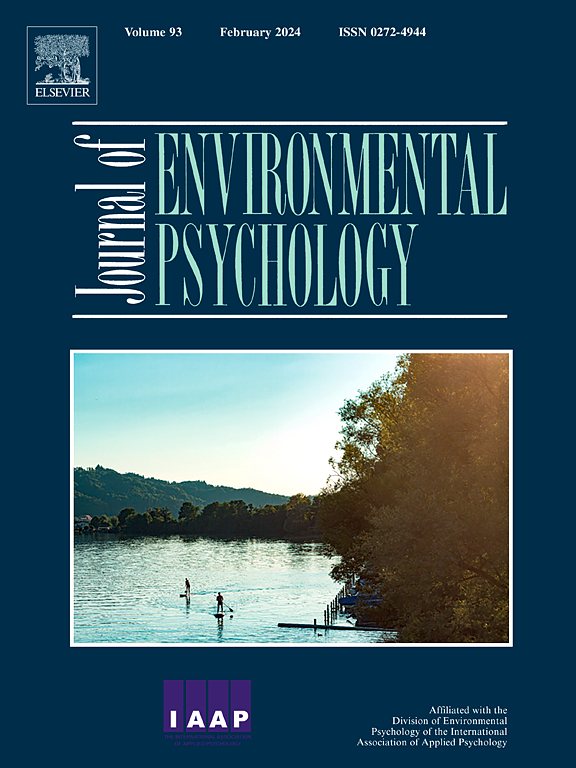From distress to action? – A three-wave longitudinal study of climate change distress, pro-environmental behavior, and coping strategies among Finnish adolescents
IF 7
1区 心理学
Q1 ENVIRONMENTAL STUDIES
引用次数: 0
Abstract
Climate change is a major threat requiring active engagement from young people. However, adolescents can experience distress when confronting the problem. This three-wave longitudinal study of 684 adolescents (ages 12–17) examines how climate change distress and pro-environmental behavior influence each other at a within-person level and the role of coping strategies (de-emphasizing, problem-focused, meaning-focused coping) in such relationships. The results reveal that higher-than-expected levels of pro-environmental behavior were associated with higher-than-expected levels of climate change distress one year later, while higher-than-expected levels of climate change distress were associated with lower-than-expected levels of pro-environmental behavior. However, the results underscore the vital role of meaning-focused coping in managing climate change distress to promote pro-environmental behavior. For adolescents utilizing a high degree of meaning-focused coping, higher-than-expected levels of climate change distress were associated with increases in pro-environmental behavior over time, whereas the influence of pro-environmental behavior on distress was nonsignificant. In addition, a bidirectional longitudinal association was discovered between higher-than-expected levels of pro-environmental behavior and problem-focused coping. Overall, the study highlights the complex longitudinal dynamics between climate change distress, pro-environmental behavior, and coping strategies. The findings underline the importance of addressing coping strategies in interventions to promote active climate engagement and reduce distress among adolescents.
从痛苦到行动?-芬兰青少年气候变化困扰、亲环境行为和应对策略的三波纵向研究
气候变化是一项重大威胁,需要年轻人积极参与。然而,青少年在面对这个问题时可能会感到痛苦。本研究对684名青少年(12-17岁)进行了三波纵向研究,探讨了气候变化困扰与亲环境行为如何在个人层面上相互影响,以及应对策略(去强调、问题关注、意义关注)在这种关系中的作用。结果表明,一年后,高于预期的亲环境行为水平与高于预期的气候变化困扰水平相关,而高于预期的气候变化困扰水平与低于预期的亲环境行为水平相关。然而,研究结果强调了以意义为中心的应对在管理气候变化困扰以促进亲环境行为方面的重要作用。对于使用高度意义聚焦应对的青少年,随着时间的推移,高于预期的气候变化痛苦水平与亲环境行为的增加相关,而亲环境行为对痛苦的影响不显著。此外,高预期水平的亲环境行为与问题关注型应对之间存在双向纵向关联。总体而言,该研究强调了气候变化困扰、亲环境行为和应对策略之间复杂的纵向动态关系。研究结果强调了在干预措施中解决应对策略的重要性,以促进积极的气候参与和减少青少年的痛苦。
本文章由计算机程序翻译,如有差异,请以英文原文为准。
求助全文
约1分钟内获得全文
求助全文
来源期刊

Journal of Environmental Psychology
Multiple-
CiteScore
10.60
自引率
8.70%
发文量
140
审稿时长
62 days
期刊介绍:
The Journal of Environmental Psychology is the premier journal in the field, serving individuals in a wide range of disciplines who have an interest in the scientific study of the transactions and interrelationships between people and their surroundings (including built, social, natural and virtual environments, the use and abuse of nature and natural resources, and sustainability-related behavior). The journal publishes internationally contributed empirical studies and reviews of research on these topics that advance new insights. As an important forum for the field, the journal publishes some of the most influential papers in the discipline that reflect the scientific development of environmental psychology. Contributions on theoretical, methodological, and practical aspects of all human-environment interactions are welcome, along with innovative or interdisciplinary approaches that have a psychological emphasis. Research areas include: •Psychological and behavioral aspects of people and nature •Cognitive mapping, spatial cognition and wayfinding •Ecological consequences of human actions •Theories of place, place attachment, and place identity •Environmental risks and hazards: perception, behavior, and management •Perception and evaluation of buildings and natural landscapes •Effects of physical and natural settings on human cognition and health •Theories of proenvironmental behavior, norms, attitudes, and personality •Psychology of sustainability and climate change •Psychological aspects of resource management and crises •Social use of space: crowding, privacy, territoriality, personal space •Design of, and experiences related to, the physical aspects of workplaces, schools, residences, public buildings and public space
 求助内容:
求助内容: 应助结果提醒方式:
应助结果提醒方式:


